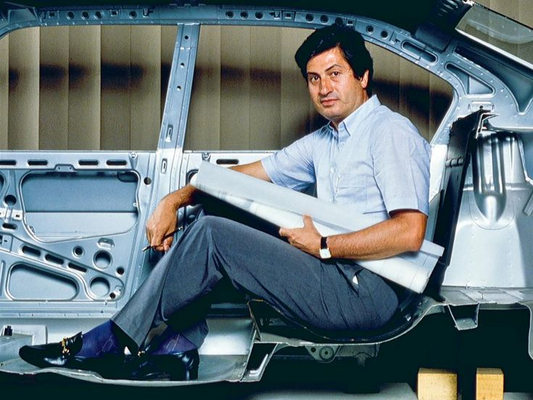Giorgetto Giugiaro is an essential name in the history of automotive design. Born on August 7, 1938, in Garessio, Italy, Giugiaro is considered one of the most influential and prolific automotive designers of the 20th century. His visionary style and functional approach not only redefined the aesthetics of cars but also indelibly shaped the industry.

Photo credit: https://www.pinterest.fr/pin/20618110774377893/
The Beginnings of His Career
Born into a family of artists (his father and grandfather were painters), Giugiaro showed a talent for drawing from an early age. After studying at the Turin Art Institute, he was spotted by Dante Giacosa, then head of design at Fiat, who opened the doors to the automotive industry for him. At just 17 years old, Giugiaro began his career at Fiat, where he participated in the first model sketches. However, his fame would truly take root when he joined the Bertone design studio in 1959.
At Bertone, Giugiaro perfected his craft and designed several landmark vehicles. Among them, the Alfa Romeo 2000 Sprint (1960) and the Giulia GT (1963) are iconic models that established him as a rising star in automotive design. His lines were characterized by their elegance, dynamism, and modernity.

Alfa Romeo 2000 Sprint / Photo credit: https://www.pinterest.fr/pin/81979655693114901/

Alfa Romeo Giulia GT / Photo credit: https://www.pinterest.fr/pin/791859547020314313/
Italdesign: The Launch of a Legend
In 1968, Giugiaro founded his own company, “Italdesign,” a design and engineering firm dedicated not only to automobiles but also to other industrial sectors. It was with Italdesign that Giugiaro truly revolutionized the automotive world. His first major commercial success was the Volkswagen Golf Mk1 (1974), a compact car that quickly became a flagship model worldwide. With its clean lines and distinct profile, the Golf is a perfect example of Giugiaro's pragmatic vision: a design that combines aesthetics and functionality.

VW Golf MK1 / Photo credit: https://www.pinterest.fr/pin/293296994461210598/
Under Giugiaro's leadership, Italdesign also diversified, designing models for numerous brands, including giants like Ferrari, Maserati, Lotus, and Lamborghini. Some of Giugiaro's most iconic models include the Lotus Esprit (1972), the Maserati Bora (1971), and the DeLorean DMC-12 (1981), made famous by the Back to the Future film trilogy.

DeLorean DMC-12 / Photo credit: https://www.pinterest.fr/pin/47076758602205269/
A Minimalist and Innovative Style
Giugiaro's style is often described as "sophisticated simplicity." He always sought to eliminate excess in design while preserving functional beauty. One of the key concepts he popularized was "form follows function," where the shape of an object or vehicle should be dictated above all by its usefulness.

Photo credit: https://www.pinterest.fr/pin/95842298299620147/
In addition to his bold designs, Giugiaro was also a pioneer in the use of new technologies and lightweight materials such as aluminum and plastics in automobile manufacturing. His designs often incorporate angular lines and precise geometry, which contrast with the dominant curves of the era. The result is a timeless style that remains modern decades after its conception.
Worldwide Recognition
Over the years, Giugiaro has received numerous awards and accolades for his contributions to automotive design. In 1999, he was named "Car Designer of the Century" by a jury of international journalists and experts. Furthermore, Italdesign continued to flourish under his leadership, and in 2010, the company was partially acquired by the Volkswagen Group, further cementing Giugiaro's influence in the industry.
A Lasting Legacy
Giorgetto Giugiaro's legacy extends beyond his automobile designs. He also contributed to projects in other fields, such as architecture, electronics, and even train design. His designs are distinguished by their ability to combine technological innovation, simplicity, and visual beauty.
Today, officially retired, Giugiaro remains a benchmark in the field of industrial design. His vision, which transformed the way cars are designed, continues to inspire new generations of designers. He demonstrated that the automobile is not just a means of transportation, but can also be a work of art, where every line, every curve, and every detail is important.

Photo credit: https://www.pinterest.fr/pin/372954412893575284/




